#data science books publishers
Text

PM Publishers Pvt. Ltd. (PMP) is a leading publishing house of educational school books. PMP books incorporate the projected NEP 2020, NIPUN BHARAT and NCF 2022 guidelines by MHRD, Gol, the Department of School Education & Literacy, MoE, Gol, and NCERT respectively. For providing cost-effective quality books, the prescribed curriculum framed by NCERT/ SCERT based for the CBSE, ICSE and other state boards forms a basis for us to cater to the needs of all stakeholders.
In a short span of time, the house has created a niche amongst educators. More than 4000 established schools both in India and abroad have already appreciated the significant presence of our books. The books are supported with the latest technology like AR Apps, Multimedia, Assessment Tools, Question Paper Generator, and Quiz Generator. Explore more
Links: https://www.pmpublishers.in/
#Books publishers#computer books publishers#gk books publishers#art & craft books publishers#artificial intelligence books publishers#data science books publishers#english grammar books publishers#environmental studies books publishers.
2 notes
·
View notes
Text
NASA Inspires Your Crafty Creations for World Embroidery Day
It’s amazing what you can do with a little needle and thread! For #WorldEmbroideryDay, we asked what NASA imagery inspired you. You responded with a variety of embroidered creations, highlighting our different areas of study.
Here’s what we found:
Webb’s Carina Nebula
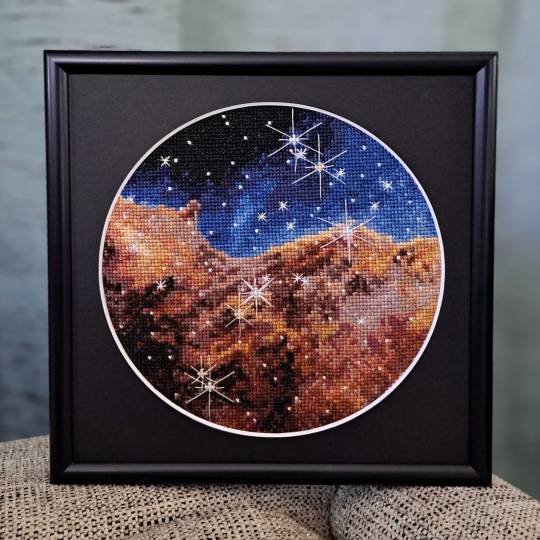
Wendy Edwards, a project coordinator with Earth Science Data Systems at NASA, created this embroidered piece inspired by Webb’s Carina Nebula image. Captured in infrared light, this image revealed for the first time previously invisible areas of star birth. Credit: Wendy Edwards, NASA. Pattern credit: Clare Bray, Climbing Goat Designs
Wendy Edwards, a project coordinator with Earth Science Data Systems at NASA, first learned cross stitch in middle school where she had to pick rotating electives and cross stitch/embroidery was one of the options. “When I look up to the stars and think about how incredibly, incomprehensibly big it is out there in the universe, I’m reminded that the universe isn’t ‘out there’ at all. We’re in it,” she said. Her latest piece focused on Webb’s image release of the Carina Nebula. The image showcased the telescope’s ability to peer through cosmic dust, shedding new light on how stars form.
Ocean Color Imagery: Exploring the North Caspian Sea

Danielle Currie of Satellite Stitches created a piece inspired by the Caspian Sea, taken by NASA’s ocean color satellites. Credit: Danielle Currie/Satellite Stitches
Danielle Currie is an environmental professional who resides in New Brunswick, Canada. She began embroidering at the beginning of the Covid-19 pandemic as a hobby to take her mind off the stress of the unknown. Danielle’s piece is titled “46.69, 50.43,” named after the coordinates of the area of the northern Caspian Sea captured by LandSat8 in 2019.

An image of the Caspian Sea captured by Landsat 8 in 2019. Credit: NASA
Two Hubble Images of the Pillars of Creation, 1995 and 2015
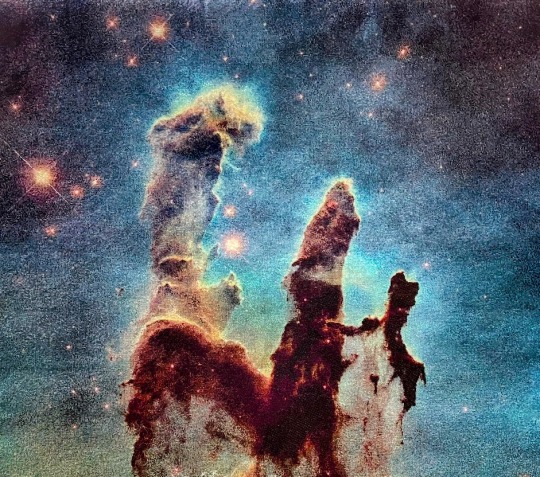
Melissa Cole of Star Stuff Stitching created an embroidery piece based on the Hubble image Pillars of Creation released in 1995. Credit: Melissa Cole, Star Stuff Stitching
Melissa Cole is an award-winning fiber artist from Philadelphia, PA, USA, inspired by the beauty and vastness of the universe. They began creating their own cross stitch patterns at 14, while living with their grandparents in rural Michigan, using colored pencils and graph paper. The Pillars of Creation (Eagle Nebula, M16), released by the Hubble Telescope in 1995 when Melissa was just 11 years old, captured the imagination of a young person in a rural, religious setting, with limited access to science education.

Lauren Wright Vartanian of the shop Neurons and Nebulas created this piece inspired by the Hubble Space Telescope’s 2015 25th anniversary re-capture of the Pillars of Creation. Credit: Lauren Wright Vartanian, Neurons and Nebulas
Lauren Wright Vartanian of Guelph, Ontario Canada considers herself a huge space nerd. She’s a multidisciplinary artist who took up hand sewing after the birth of her daughter. She’s currently working on the illustrations for a science themed alphabet book, made entirely out of textile art. It is being published by Firefly Books and comes out in the fall of 2024. Lauren said she was enamored by the original Pillars image released by Hubble in 1995. When Hubble released a higher resolution capture in 2015, she fell in love even further! This is her tribute to those well-known images.
James Webb Telescope Captures Pillars of Creation

Darci Lenker of Darci Lenker Art, created a rectangular version of Webb’s Pillars of Creation. Credit: Darci Lenker of Darci Lenker Art
Darci Lenker of Norman, Oklahoma started embroidery in college more than 20 years ago, but mainly only used it as an embellishment for her other fiber works. In 2015, she started a daily embroidery project where she planned to do one one-inch circle of embroidery every day for a year. She did a collection of miniature thread painted galaxies and nebulas for Science Museum Oklahoma in 2019. Lenker said she had previously embroidered the Hubble Telescope’s image of Pillars of Creation and was excited to see the new Webb Telescope image of the same thing. Lenker could not wait to stitch the same piece with bolder, more vivid colors.
Milky Way

Darci Lenker of Darci Lenker Art was inspired by NASA’s imaging of the Milky Way Galaxy. Credit: Darci Lenker
In this piece, Lenker became inspired by the Milky Way Galaxy, which is organized into spiral arms of giant stars that illuminate interstellar gas and dust. The Sun is in a finger called the Orion Spur.
The Cosmic Microwave Background
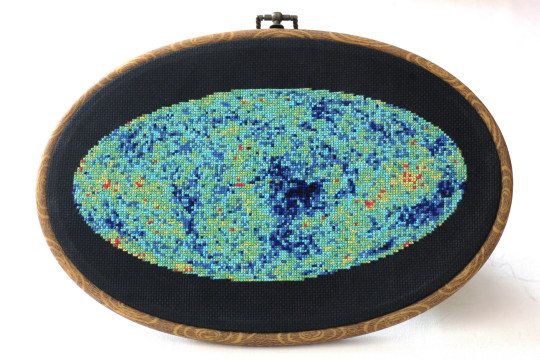
This image shows an embroidery design based on the cosmic microwave background, created by Jessica Campbell, who runs Astrostitches. Inside a tan wooden frame, a colorful oval is stitched onto a black background in shades of blue, green, yellow, and a little bit of red. Credit: Jessica Campbell/ Astrostitches
Jessica Campbell obtained her PhD in astrophysics from the University of Toronto studying interstellar dust and magnetic fields in the Milky Way Galaxy. Jessica promptly taught herself how to cross-stitch in March 2020 and has since enjoyed turning astronomical observations into realistic cross-stitches. Her piece was inspired by the cosmic microwave background, which displays the oldest light in the universe.

The full-sky image of the temperature fluctuations (shown as color differences) in the cosmic microwave background, made from nine years of WMAP observations. These are the seeds of galaxies, from a time when the universe was under 400,000 years old. Credit: NASA/WMAP Science Team
GISSTEMP: NASA’s Yearly Temperature Release

Katy Mersmann, a NASA social media specialist, created this embroidered piece based on NASA’s Goddard Institute for Space Studies (GISS) global annual temperature record. Earth’s average surface temperature in 2020 tied with 2016 as the warmest year on record. Credit: Katy Mersmann, NASA
Katy Mersmann is a social media specialist at NASA’s Goddard Space Flight Center in Greenbelt, Md. She started embroidering when she was in graduate school. Many of her pieces are inspired by her work as a communicator. With climate data in particular, she was inspired by the researchers who are doing the work to understand how the planet is changing. The GISTEMP piece above is based on a data visualization of 2020 global temperature anomalies, still currently tied for the warmest year on record.
In addition to embroidery, NASA continues to inspire art in all forms. Check out other creative takes with Landsat Crafts and the James Webb Space telescope public art gallery.
Make sure to follow us on Tumblr for your regular dose of space!
#NASA#creativity#fiber art#embroidery#art#art challenge#needlework#crafts#handmade#textile art#cross stitch#stitching#inspiration#inspo#Earth#Earth science#Hubble#James Webb Space Telescope#climate change#water#nebula#stars
6K notes
·
View notes
Text
The Coprophagic AI crisis

I'm on tour with my new, nationally bestselling novel The Bezzle! Catch me in TORONTO on Mar 22, then with LAURA POITRAS in NYC on Mar 24, then Anaheim, and more!

A key requirement for being a science fiction writer without losing your mind is the ability to distinguish between science fiction (futuristic thought experiments) and predictions. SF writers who lack this trait come to fancy themselves fortune-tellers who SEE! THE! FUTURE!
The thing is, sf writers cheat. We palm cards in order to set up pulp adventure stories that let us indulge our thought experiments. These palmed cards – say, faster-than-light drives or time-machines – are narrative devices, not scientifically grounded proposals.
Historically, the fact that some people – both writers and readers – couldn't tell the difference wasn't all that important, because people who fell prey to the sf-as-prophecy delusion didn't have the power to re-orient our society around their mistaken beliefs. But with the rise and rise of sf-obsessed tech billionaires who keep trying to invent the torment nexus, sf writers are starting to be more vocal about distinguishing between our made-up funny stories and predictions (AKA "cyberpunk is a warning, not a suggestion"):
https://www.antipope.org/charlie/blog-static/2023/11/dont-create-the-torment-nexus.html
In that spirit, I'd like to point to how one of sf's most frequently palmed cards has become a commonplace of the AI crowd. That sleight of hand is: "add enough compute and the computer will wake up." This is a shopworn cliche of sf, the idea that once a computer matches the human brain for "complexity" or "power" (or some other simple-seeming but profoundly nebulous metric), the computer will become conscious. Think of "Mike" in Heinlein's *The Moon Is a Harsh Mistress":
https://en.wikipedia.org/wiki/The_Moon_Is_a_Harsh_Mistress#Plot
For people inflating the current AI hype bubble, this idea that making the AI "more powerful" will correct its defects is key. Whenever an AI "hallucinates" in a way that seems to disqualify it from the high-value applications that justify the torrent of investment in the field, boosters say, "Sure, the AI isn't good enough…yet. But once we shovel an order of magnitude more training data into the hopper, we'll solve that, because (as everyone knows) making the computer 'more powerful' solves the AI problem":
https://locusmag.com/2023/12/commentary-cory-doctorow-what-kind-of-bubble-is-ai/
As the lawyers say, this "cites facts not in evidence." But let's stipulate that it's true for a moment. If all we need to make the AI better is more training data, is that something we can count on? Consider the problem of "botshit," Andre Spicer and co's very useful coinage describing "inaccurate or fabricated content" shat out at scale by AIs:
https://papers.ssrn.com/sol3/papers.cfm?abstract_id=4678265
"Botshit" was coined last December, but the internet is already drowning in it. Desperate people, confronted with an economy modeled on a high-speed game of musical chairs in which the opportunities for a decent livelihood grow ever scarcer, are being scammed into generating mountains of botshit in the hopes of securing the elusive "passive income":
https://pluralistic.net/2024/01/15/passive-income-brainworms/#four-hour-work-week
Botshit can be produced at a scale and velocity that beggars the imagination. Consider that Amazon has had to cap the number of self-published "books" an author can submit to a mere three books per day:
https://www.theguardian.com/books/2023/sep/20/amazon-restricts-authors-from-self-publishing-more-than-three-books-a-day-after-ai-concerns
As the web becomes an anaerobic lagoon for botshit, the quantum of human-generated "content" in any internet core sample is dwindling to homeopathic levels. Even sources considered to be nominally high-quality, from Cnet articles to legal briefs, are contaminated with botshit:
https://theconversation.com/ai-is-creating-fake-legal-cases-and-making-its-way-into-real-courtrooms-with-disastrous-results-225080
Ironically, AI companies are setting themselves up for this problem. Google and Microsoft's full-court press for "AI powered search" imagines a future for the web in which search-engines stop returning links to web-pages, and instead summarize their content. The question is, why the fuck would anyone write the web if the only "person" who can find what they write is an AI's crawler, which ingests the writing for its own training, but has no interest in steering readers to see what you've written? If AI search ever becomes a thing, the open web will become an AI CAFO and search crawlers will increasingly end up imbibing the contents of its manure lagoon.
This problem has been a long time coming. Just over a year ago, Jathan Sadowski coined the term "Habsburg AI" to describe a model trained on the output of another model:
https://twitter.com/jathansadowski/status/1625245803211272194
There's a certain intuitive case for this being a bad idea, akin to feeding cows a slurry made of the diseased brains of other cows:
https://www.cdc.gov/prions/bse/index.html
But "The Curse of Recursion: Training on Generated Data Makes Models Forget," a recent paper, goes beyond the ick factor of AI that is fed on botshit and delves into the mathematical consequences of AI coprophagia:
https://arxiv.org/abs/2305.17493
Co-author Ross Anderson summarizes the finding neatly: "using model-generated content in training causes irreversible defects":
https://www.lightbluetouchpaper.org/2023/06/06/will-gpt-models-choke-on-their-own-exhaust/
Which is all to say: even if you accept the mystical proposition that more training data "solves" the AI problems that constitute total unsuitability for high-value applications that justify the trillions in valuation analysts are touting, that training data is going to be ever-more elusive.
What's more, while the proposition that "more training data will linearly improve the quality of AI predictions" is a mere article of faith, "training an AI on the output of another AI makes it exponentially worse" is a matter of fact.

Name your price for 18 of my DRM-free ebooks and support the Electronic Frontier Foundation with the Humble Cory Doctorow Bundle.

If you'd like an essay-formatted version of this post to read or share, here's a link to it on pluralistic.net, my surveillance-free, ad-free, tracker-free blog:
https://pluralistic.net/2024/03/14/14/inhuman-centipede#enshittibottification

Image:
Plamenart (modified)
https://commons.wikimedia.org/wiki/File:Double_Mobius_Strip.JPG
CC BY-SA 4.0
https://creativecommons.org/licenses/by-sa/4.0/deed.en
#pluralistic#ai#generative ai#André Spicer#botshit#habsburg ai#jathan sadowski#ross anderson#inhuman centipede#science fiction#mysticism
552 notes
·
View notes
Text

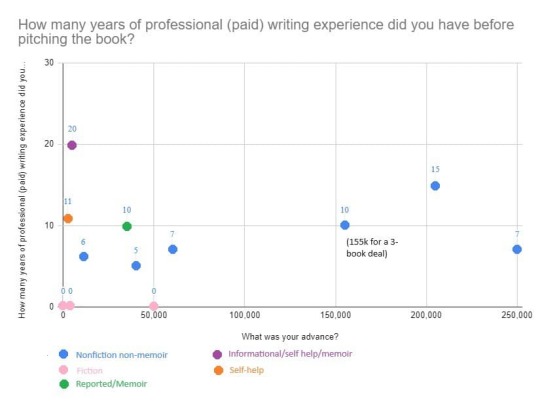
Do nonfiction authors really need social media to get a book deal?
I asked successful agents and trad signed authors how important social media is to getting book contracts. Here are some data and quotes about how they responded on my Authors of Nonfiction Books in Progress Substack! Read if you want more details and caveats to the data, as well as my story and why I like social media anyway.
TLDR: Social media is NOT necessary!
Here's an editorial explaining why. But for nonfiction non-memoir, you have to do something to prove that you know what you’re talking about, as you'll see repeated over and over in my Substack article. That proof could be social media.
Trad publishing is very hard and competitive, and sometimes even unfair. But the people who say "you can't get a deal unless you know someone or are TikTok famous" are flat-out wrong. (Also, you can become a person who knows someone by joining communities, attending conferences...hell, you can DM me if you have writing experience and I might hook you up with my agent. There, now you know someone and have no excuse. I've successfully hooked up 4 people I knew from communities I'm in, or something like that, not because they're my family members. I have said "come back when your query and/or experience are better" to 3 people, and 2 people didn't get the deal despite having good pitches and my recommendation, it just wasn't a match.)
Unfortunately, I think some aspiring authors are looking for an excuse, as many of these people don't often tend their writing craft. That is a much bigger indicator as to whether you'll get a deal, even if the trad world still isn't a perfect meritocracy.
Remember, I LOVE social media and have over 300,000 followers across platforms. I mostly do recommend that writers and journalists should use it! I find it sad, even, that there are so many writers with no audiences, when there are huge social audiences who would love to hear what these writers have to say! (But there are downsides too, so it's not ideal for all. Check out the pros and cons for science journalists being on TikTok.)
If you’d like to share your experience with trad publishing and social media (or lack of social media!), I still look at the survey results, so feel free to fill it out here and I may share the results in the future. Some questions are optional and of course I redact the (optional, anyway) emails:
67 notes
·
View notes
Text
We’re often told that it would be unfeasible for everyone on the planet to live good lives—that if there wasn’t some degree of poverty—or at least lower living standards—in the rest of the world, then we’d blow right through the ecological limits of the planet. Even if it’s not said explicitly, the argument is that some people need to be poor in order for us in the Global North to live good lives. There’s a lot wrong with this assumption on a lot of different levels, but most importantly—it’s empirically inaccurate.
It is possible, in fact, for everybody on the planet to have their needs met and to live a good life and make it happen, in fact, with only 30 percent of current global resource and energy use. That might sound unbelievable, right? Well, that’s capitalist realism for you. Because not only is it believable—it’s based on solid research and empirical data. It would, however, require ending capitalism and moving towards eco-socialism. So yes, it’s possible. But it won’t be easy.
To discuss the research behind these exciting findings we’ve brought on economic anthropologist Jason Hickel. Jason is a professor at the The Institute for Environmental Science and Technology at the Autonomous University of Barcelona, and the author of the books The Divide: A Brief Guide to Global Inequality and its Solutions and Less is More: How Degrowth will Save the World. He’s the lead author of the paper “How much growth is required to achieve good lives for all? Insights from needs-based analysis” published in the journal World Development Perspectives, and which we’ll be discussing today.
As you may know, Jason is a regular guest on the show and was on most recently to discuss two other fascinating and important papers he recently co-authored, “Imperialist appropriation in the world economy: Drain from the global South through unequal exchange, 1990–2015” published in journal Global Environmental Change and "Unequal exchange of labour in the world economy" published in the journal Nature Communications.
What assumptions go into traditional economic thinking and how have they limited the way we conceptualize poverty and how we address it? How do we conceive of good lives—and how does our current economic system limit these conceptions and perpetuate environmental destruction and social immiseration? What would an economic system that is designed around meeting actual human and planetary needs look like? And, perhaps most importantly, how do we get there? These are just some of the questions we discuss in this fascinating conversation with economic anthropologist Jason Hickel.
51 notes
·
View notes
Text
For three months this year, I bled nearly every day. My doctor doesn’t know why. Google doesn’t know why. The condition is simply called “postmenopausal bleeding,” and medicine’s best guess as to the cause is that the postmenopausal hormone-replacement therapy I started last November suddenly made my endometrium, the lining of the uterus, “unstable.” All scientific knowledge added up to “If it’s still happening in six months, get back in touch.” (I’m still bleeding intermittently, and I don’t know why.) This is the kind of massive medical shrug that anyone with female anatomy has probably encountered.
Despite major advances for women over the past 100 years—the invention of the contraceptive pill, greater access to safe abortions—much of female biology is still woefully underserved by science. There are reasons for this, most notably the historical exclusion of women from medical and pharmaceutical trials, partly because our awkward hormone cycles were thought to skew results. There’s also the fact that some scientists still project findings from research on men onto women, seeming not to realize that women aren’t just small men: Women are different down to the cellular level, meaning that many of our immune responses, experiences of pain, and symptoms (including, for instance, those that accompany a heart attack) may be different from men’s. Are you having a nasty, unexpected side effect from your medication? That could be because most drugs were developed with male bodies in mind. A 2020 review of 86 common medications, including antidepressants, cardiovascular drugs, and painkillers, found that women were likely routinely overmedicated and suffered adverse reactions nearly twice as often as men.
The lagging science is particularly apparent when it comes to periods and female hormones more generally—the subject of the anthropologist Kate Clancy’s new book, Period, a scientific and cultural history that purports to tell the “real story of menstruation.” Clancy’s book makes clear that a lack of data is to blame for many of the ills that women and girls face concerning their reproductive health, like doctors’ failure to diagnose painful conditions such as endometriosis.
My severe endometriosis was discovered only when I was 41, accidentally. For decades, I had been given prescription-strength painkillers, and my doctor never seemed to wonder whether the amount of pain I was in was abnormal. When I published an essay about my menopausal depression in 2018, a deluge of women wrote to tell me that when they were going through something similar, their doctors had told them they were imagining their brain fog or panic attacks, or had put them on antidepressants that didn’t work because many depression drugs are inadequate to treat the symptoms of fluctuating estrogen.
#feminism#save#menstruation#Medical misogyny#Period positivity#When I went to type in menstruation 'menstruation tw' was the 1st result
471 notes
·
View notes
Note
Having recently moved i was organizing my books and had to look up the order of your wizards series and found out the book after i stopped reading was Wizard of Mars. Which saddened me a bit because i love space stuff and had missed that and now around 2 decades I'm wondering how hard it would be to get into it. Still, I'm gonna hold on to these books and give them to my niece in a few years when she's around the right age, I'm sure she'll like them
I think I can safely say that no matter how much older you've gotten after finishing Wizards at War, you shouldn't have too much trouble getting into A Wizard of Mars. (Not least because I went to a lot of trouble to make sure the science was current, while also knowing more and better data would be coming along fairly soon, and not wanting what was going on in the book to get dated.)
The YW books are broadly classified by their publisher as "middle-grade", sure... as the lower recommended age to come at them. But I don't think there's an upper one. Don't forget that the writer's an adult in her late middle age, and while (naturally) working to keep the work accessible for younger readers, she writes first and foremost to amuse and engage herself. This position sometimes shocks people when they hear it. But a book that won't keep me interested isn't one I'd inflict on anyone else, no matter how old or young they are.
Whatever age you start reading these books, after (more or less) your young teens, is the "right age." I do hope your niece will enjoy them. But I'm pretty sure the newer ones will have something for you too.
159 notes
·
View notes
Text
One more day to contribute to fandom science, and if you've already submitted your response here's some fun facts about Good Omens fic on ao3 for you:
Prior to the release of the first season, there were 3,574 fics on ao3 under the Good Omens book fandom tag. Especially compared to current numbers, they are almost overwhelmingly general and teen. Popular tags included fluff, humor, crossover, established relationship, romance, and drabble.
The "anal sex" tag did not make its debut on the top tags list until January of 2024. The ratio of explicit fics is also much higher than any month since the s2 release. Y'all nasty (I love you).
The longest fic under the GO Tv tag is 1,041,533 words with over 200 chapters and is published in spanish. The second place is at 500k, also in Spanish. The third, and the longest english fic, is 479,886 words and 56 chapters, and it's a rarepair Crowley/Gabriel with Aziraphale as the villain. Interesting choices were made here, major respect for the author. Takes guts.
There are 150 pages of fic, or about 3,000 fics, with less than 50 words (my cutoff for calculating average wordcount). That's 3k archived works consisting of podfics, artwork, and short poetry. Very cool!
Y'all are all simps and suckers. With the singular exception of August 2023 (Neil you know what you did), the top tag accross all dates I pulled data from was always fluff.
As I said, if you haven't already PLEASE PLEASE PLEASE GO VOTE to contribute to the biggest survey of Good Omens fanfic statistics made to date, and maybe give this or the poll a reblog to get it in front of more writers.

Bonus fun fact: In the time it took me to type this post, 4 more fics were posted.
#will reblog in the morning#since it's literally one am#but it's fine everything is fine#this has been so fun and interesting and I can't wait to share all my math with you#good omens#good omens fandom#gomens#good omens 2#ao3#fandom meta#for science#good omens fanfiction#gomens fanfic data analysis#I need a snazzier tag for all this shit but that will work for now#also don't y'all come bitching at me that archival data is technically closer to a humanity or social science I don't wanna hear it
114 notes
·
View notes
Text
What is a Cypherpunk?
The term "cypherpunk" refers to a movement and a community of activists advocating for the widespread use of strong cryptography and privacy-enhancing technologies as a route to social and political change. Emerging in the late 1980s and early 1990s, the cypherpunk movement is a confluence of libertarian political philosophy, hacker ethos, and cryptographic science.
The Core Traits of Cypherpunks
1. Advocacy for Privacy and Anonymity: Cypherpunks champion the right to privacy, emphasizing that individuals should have control over their personal information and digital footprints. This advocacy is often in direct opposition to government surveillance and corporate data collection practices.
2. Use of Cryptography: The cornerstone of the cypherpunk movement is the use of strong cryptography to secure communications and transactions. Cypherpunks believe that through cryptographic techniques, individuals can protect their privacy in the digital world.
3. Open Source and Decentralization: A significant trait among cypherpunks is the belief in open-source software and decentralized systems. This ethos promotes transparency, security, and resistance to censorship and control by central authorities.
Who are the Cypherpunks?
The cypherpunk community consists of programmers, activists, academics, and technologists. Notable figures include Julian Assange, the founder of WikiLeaks; Jacob Appelbaum, a former spokesperson for the Tor Project; and Hal Finney, a pioneer in digital cash systems. The manifesto "A Cypherpunk's Manifesto" by Eric Hughes (1993) [https://www.activism.net/cypherpunk/manifesto.html] eloquently encapsulates the philosophy and ideals of this movement.
The Cypherpunk Movement
Cypherpunks are not a formal organization but rather a loosely associated group sharing common interests in cryptography and privacy. The movement's origins can be traced to the “Cypherpunks” mailing list, started in 1992 by Eric Hughes, Timothy C. May, and John Gilmore. This list served as a platform for discussing privacy, cryptography, and related political issues.
Relation to Cyberpunk Principles
While cypherpunks share some overlap with the cyberpunk genre of science fiction, they are distinct in their real-world activism. Cyberpunk literature, like William Gibson's "Neuromancer" (1984) [https://www.goodreads.com/book/show/6088006-neuromancer], often presents a dystopian future where technology is pervasive and oppressive. In contrast, cypherpunks aim to use technology, specifically cryptography, as a tool for empowerment and resistance against such dystopian futures.
Notable Contributions and Technologies
The cypherpunk movement has been instrumental in the development of technologies that emphasize privacy and security:
Tor (The Onion Router): A free and open-source software for enabling anonymous communication [https://www.torproject.org/].
Pretty Good Privacy (PGP): A data encryption and decryption program that provides cryptographic privacy and authentication [https://www.openpgp.org/].
Bitcoin: The creation of Bitcoin by an individual or group under the pseudonym Satoshi Nakamoto was heavily influenced by the ideas of the cypherpunk movement. It embodies principles of decentralization and financial privacy [https://bitcoin.org/en/].
Wikileaks: Founded by Julian Assange, WikiLeaks is a multinational media organization that publishes news leaks and classified media provided by anonymous sources [https://wikileaks.org/].
Conclusion
The cypherpunk movement is a critical lens through which to view the ongoing dialogue about privacy, security, and freedom in the digital age. While not an organized group, the collective impact of cypherpunks on modern cryptography, internet privacy, and digital rights is profound. As digital technology continues to permeate every facet of our lives, the principles and contributions of the cypherpunk community remain more relevant than ever. - REV1.
80 notes
·
View notes
Text

(...) proponents of the Man the Hunter theory assumed evolution was acting primarily on men, and women were merely passive beneficiaries of both the meat supply and evolutionary progress.
(...) The modern physiological evidence, along with historical examples, exposes deep flaws in the idea that physical inferiority prevented females from partaking in hunting during our evolutionary past. The evidence from prehistory further undermines this notion.
(...) For those practicing a foraging subsistence strategy in small family groups, flexibility and adaptability are much more important than rigid roles, gendered or otherwise. Individuals get injured or die, and the availability of animal and plant foods changes with the seasons. All group members need to be able to step into any role depending on the situation, whether that role is hunter or breeding partner.
more discussion of the specific evidence in the article -- please give it a read! full text under readmore if you cant get the link to work
The Theory That Men Evolved to Hunt and Women Evolved to Gather Is Wrong
Cara Ocobock, Sarah Lacy
18 - 23 minutes
Even if you're not an anthropologist, you've probably encountered one of this field's most influential notions, known as Man the Hunter. The theory proposes that hunting was a major driver of human evolution and that men carried this activity out to the exclusion of women. It holds that human ancestors had a division of labor, rooted in biological differences between males and females, in which males evolved to hunt and provide and females tended to children and domestic duties. It assumes that males are physically superior to females and that pregnancy and child-rearing reduce or eliminate a female's ability to hunt.
Man the Hunter has dominated the study of human evolution for nearly half a century and pervaded popular culture. It is represented in museum dioramas and textbook figures, Saturday morning cartoons and feature films. The thing is, it's wrong.
Mounting evidence from exercise science indicates that women are physiologically better suited than men to endurance efforts such as running marathons. This advantage bears on questions about hunting because a prominent hypothesis contends that early humans are thought to have pursued prey on foot over long distances until the animals were exhausted. Furthermore, the fossil and archaeological records, as well as ethnographic studies of modern-day hunter-gatherers, indicate that women have a long history of hunting game. We still have much to learn about female athletic performance and the lives of prehistoric women. Nevertheless, the data we do have signal that it is time to bury Man the Hunter for good.
youtube
The theory rose to prominence in 1968, when anthropologists Richard B. Lee and Irven DeVore published Man the Hunter, an edited collection of scholarly papers presented at a 1966 symposium on contemporary hunter-gatherer societies. The volume drew on ethnographic, archaeological and paleoanthropological evidence to argue that hunting is what drove human evolution and resulted in our suite of unique features. "Man's life as a hunter supplied all the other ingredients for achieving civilization: the genetic variability, the inventiveness, the systems of vocal communication, the coordination of social life," anthropologist William S. Laughlin writes in chapter 33 of the book. Because men were supposedly the ones hunting, proponents of the Man the Hunter theory assumed evolution was acting primarily on men, and women were merely passive beneficiaries of both the meat supply and evolutionary progress.
But Man the Hunter's contributors often ignored evidence, sometimes in their own data, that countered their suppositions. For example, Hitoshi Watanabe focused on ethnographic data about the Ainu, an Indigenous population in northern Japan and its surrounding areas. Although Watanabe documented Ainu women hunting, often with the aid of dogs, he dismissed this finding in his interpretations and placed the focus squarely on men as the primary meat winners. He was superimposing the idea of male superiority through hunting onto the Ainu and into the past.
This fixation on male superiority was a sign of the times not just in academia but in society at large. In 1967, the year between the Man the Hunter conference and the publication of the edited volume, 20-year-old Kathrine Switzer entered the Boston Marathon under the name "K. V. Switzer," which obscured her gender. There were no official rules against women entering the race; it just was not done. When officials discovered that Switzer was a woman, race manager Jock Semple attempted to push her physically off the course.
At that time, the conventional wisdom was that women were incapable of completing such a physically demanding task and that attempting to do so could harm their precious reproductive capacities. Scholars following Man the Hunter dogma relied on this belief in women's limited physical capacities and the assumed burden of pregnancy and lactation to argue that only men hunted. Women had children to rear instead.
Today these biased assumptions persist in both the scientific literature and the public consciousness. Granted, women have recently been shown hunting in movies such as Prey, the newest installment of the popular Predator franchise, and on cable programs such as Naked and Afraid and Women Who Hunt. But social media trolls have viciously critiqued and labeled these depictions as part of a politically correct feminist agenda. They insist the creators of such works are trying to rewrite gender roles and evolutionary history in an attempt to co-opt "traditionally masculine" social spheres. Bystanders might be left wondering whether portrayals of women hunters are trying to make the past more inclusive than it really was—or whether Man the Hunter-style assumptions about the past are attempts to project sexism backward in time. Our recent surveys of the physiological and archaeological evidence for hunting capability and sexual division of labor in human evolution answer this question.

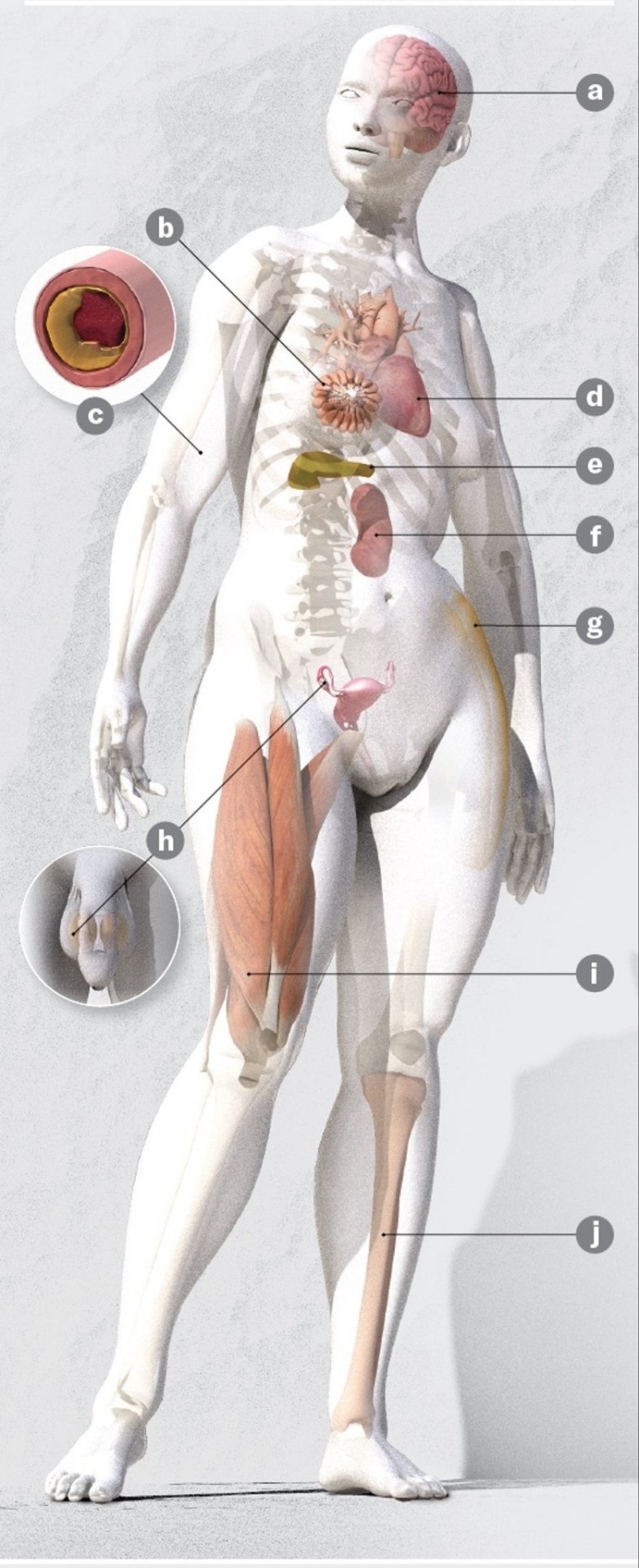
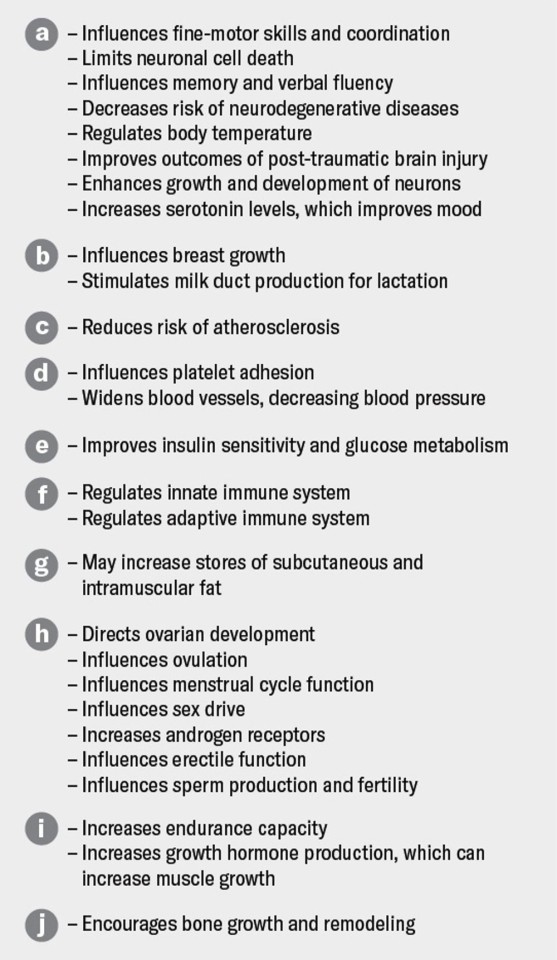
Credit: Violet Isabelle Frances for Bryan Christie Design
Before getting into the evidence, we need to first talk about sex and gender. "Sex" typically refers to biological sex, which can be defined by myriad characteristics such as chromosomes, hormone levels, gonads, external genitalia and secondary sex characteristics. The terms "female" and "male" are often used in relation to biological sex. "Gender" refers to how an individual identifies—woman, man, nonbinary, and so forth. Much of the scientific literature confuses and conflates female/male and woman/man terminology without providing definitions to clarify what it is referring to and why those terms were chosen. For the purpose of describing anatomical and physiological evidence, most of the literature uses "female" and "male," so we use those words here when discussing the results of such studies. For ethnographic and archaeological evidence, we are attempting to reconstruct social roles, for which the terms "woman" and "man" are usually used. Unfortunately, both these word sets assume a binary, which does not exist biologically, psychologically or socially. Sex and gender both exist as a spectrum, but it is difficult to add that nuance when citing the work of others.
It also bears mentioning that much of the research into exercise physiology, paleoanthropology, archaeology and ethnography has historically been conducted by men and focused on males. For example, Ella Smith of the Australian Catholic University and her colleagues found that in studies of nutrition and supplements, only 23 percent of participants were female. Emma Cowley, then at the University of North Carolina at Chapel Hill, and her colleagues found that among published studies focusing on athletic performance, only 6 percent had female-only participants; 31 percent looked exclusively at males. This massive disparity means we still know very little about female athletic performance, training and nutrition, leaving athletic trainers and coaches to treat females mostly as small males. It also means that much of the work we have to rely on to make our physiological arguments about female hunters in prehistory is based on research with small human sample sizes or rodent studies. We hope this state of affairs will inspire the next generation of scientists to ensure that females are represented in such studies. But even with the limited data available to us, we can show that Man the Hunter is a flawed theory and make the case that females in early human communities hunted, too.
From a biological standpoint, there are undeniable differences between females and males. When we discuss these differences, we are typically referring to means, averages of one group compared with another. Means obscure the vast range of variation in humans. For instance, although males tend to be larger and to have bigger hearts and lungs and more muscle mass, there are plenty of females who fall within the typical male range; the inverse is also true.
Overall, females are metabolically better suited for endurance activities, whereas males excel at short, powerful burst-type activities. You can think of it as marathoners (females) versus powerlifters (males). Much of this difference seems to be driven by the powers of the hormone estrogen.
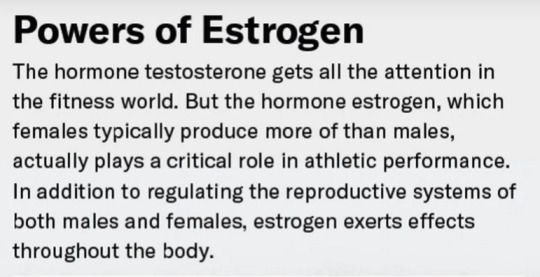
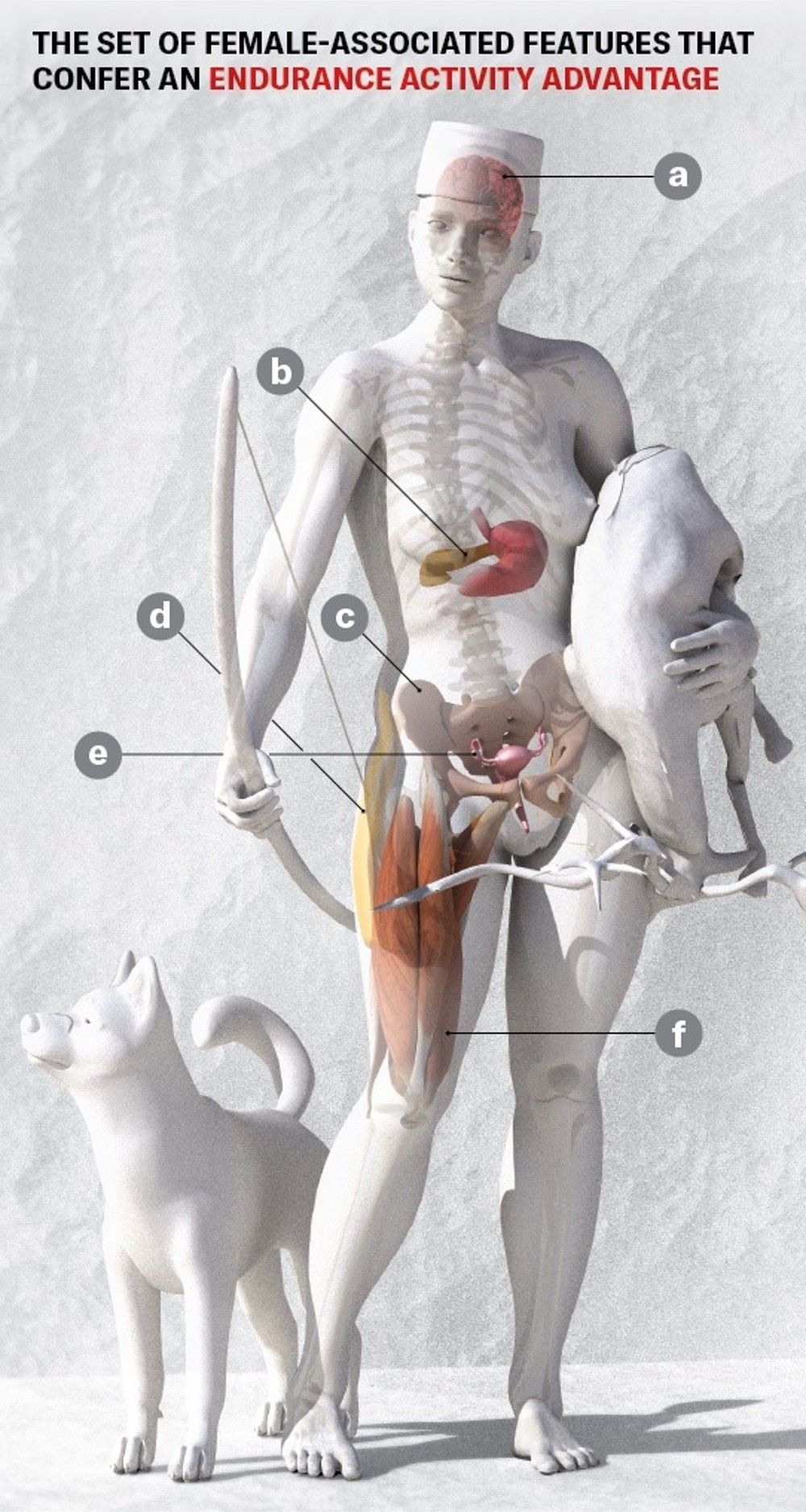
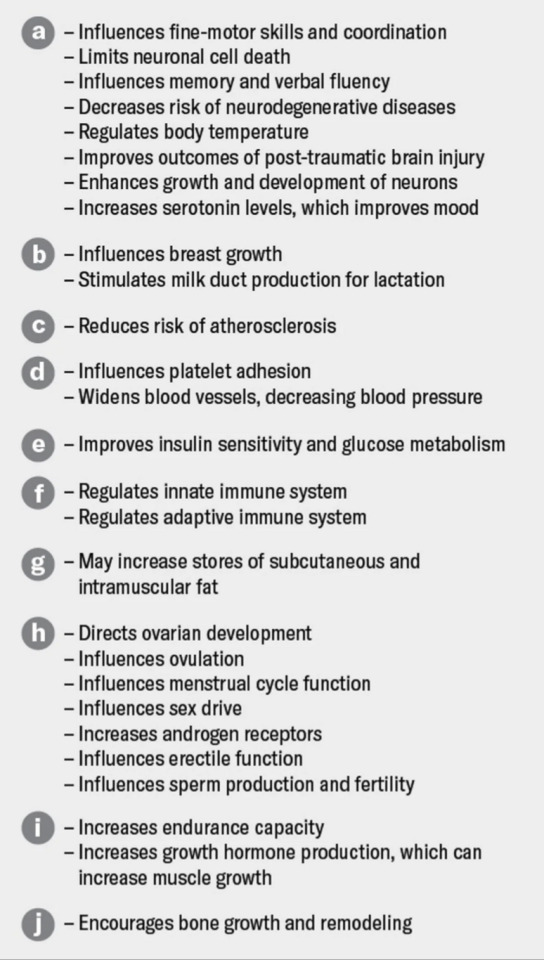

Credit: Violet Isabelle Frances for Bryan Christie Design
Given the fitness world's persistent touting of the hormone testosterone for athletic success, you'd be forgiven for not knowing that estrogen, which females typically produce more of than males, plays an incredibly important role in athletic performance. It makes sense from an evolutionary standpoint, however. The estrogen receptor—the protein that estrogen binds to in order to do its work—is deeply ancient. Joseph Thornton of the University of Chicago and his colleagues have estimated that it is around 1.2 billion to 600 million years old—roughly twice as old as the testosterone receptor. In addition to helping regulate the reproductive system, estrogen influences fine-motor control and memory, enhances the growth and development of neurons, and helps to prevent hardening of the arteries.
Important for the purposes of this discussion, estrogen also improves fat metabolism. During exercise, estrogen seems to encourage the body to use stored fat for energy before stored carbohydrates. Fat contains more calories per gram than carbohydrates do, so it burns more slowly, which can delay fatigue during endurance activity. Not only does estrogen encourage fat burning, but it also promotes greater fat storage within muscles—marbling if you will—which makes that fat's energy more readily available. Adiponectin, another hormone that is typically present in higher amounts in females than in males, further enhances fat metabolism while sparing carbohydrates for future use, and it protects muscle from breakdown. Anne Friedlander of Stanford University and her colleagues found that females use as much as 70 percent more fat for energy during exercise than males.
Correspondingly, the muscle fibers of females differ from those of males. Females have more type I, or "slow-twitch," muscle fibers than males do. These fibers generate energy slowly by using fat. They are not all that powerful, but they take a long time to become fatigued. They are the endurance muscle fibers. Males, in contrast, typically have more type II ("fast-twitch") fibers, which use carbohydrates to provide quick energy and a great deal of power but tire rapidly.
Females also tend to have a greater number of estrogen receptors on their skeletal muscles compared with males. This arrangement makes these muscles more sensitive to estrogen, including to its protective effect after physical activity. Estrogen's ability to increase fat metabolism and regulate the body's response to the hormone insulin can help prevent muscle breakdown during intense exercise. Furthermore, estrogen appears to have a stabilizing effect on cell membranes that might otherwise rupture from acute stress brought on by heat and exercise. Ruptured cells release enzymes called creatine kinases, which can damage tissues.
Studies of females and males during and after exercise bolster these claims. Linda Lamont of the University of Rhode Island and her colleagues, as well as Michael Riddell of York University in Canada and his colleagues, found that females experienced less muscle breakdown than males after the same bouts of exercise. Tellingly, in a separate study, Mazen J. Hamadeh of York University and his colleagues found that males supplemented with estrogen suffered less muscle breakdown during cycling than those who didn't receive estrogen supplements. In a similar vein, research led by Ron Maughan of the University of St. Andrews in Scotland found that females were able to perform significantly more weight-lifting repetitions than males at the same percentages of their maximal strength.
If females are better able to use fat for sustained energy and keep their muscles in better condition during exercise, then they should be able to run greater distances with less fatigue relative to males. In fact, an analysis of marathons carried out by Robert Deaner of Grand Valley State University demonstrated that females tend to slow down less as a race progresses compared with males.
If you follow long-distance races, you might be thinking, wait—males are outperforming females in endurance events! But this is only sometimes the case. Females are more regularly dominating ultraendurance events such as the more than 260-mile Montane Spine foot race through England and Scotland, the 21-mile swim across the English Channel and the 4,300-mile Trans Am cycling race across the U.S. Sometimes female athletes compete in these races while attending to the needs of their children. In 2018 English runner Sophie Power ran the 105-mile Ultra-Trail du Mont-Blanc race in the Alps while still breastfeeding her three-month-old at rest stations.
Inequity between male and female athletes is a result not of inherent biological differences between the sexes but of biases in how they are treated in sports. As an example, some endurance-running events allow the use of professional runners called pacesetters to help competitors perform their best. Men are not permitted to act as pacesetters in many women's events because of the belief that they will make the women "artificially faster," as though women were not actually doing the running themselves.
The modern physiological evidence, along with historical examples, exposes deep flaws in the idea that physical inferiority prevented females from partaking in hunting during our evolutionary past. The evidence from prehistory further undermines this notion.
Consider the skeletal remains of ancient people. Differences in body size between females and males of a species, a phenomenon called sexual size dimorphism, correlate with social structure. In species with pronounced size dimorphism, larger males compete with one another for access to females, and among the great apes larger males socially dominate females. Low sexual size dimorphism is characteristic of egalitarian and monogamous species. Modern humans have low sexual size dimorphism compared with the other great apes. The same goes for human ancestors spanning the past two million years, suggesting that the social structure of humans changed from that of our chimpanzeelike ancestors.
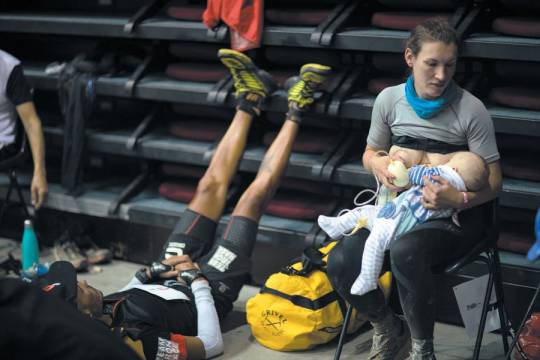
Sophie Power ran the 105-mile Ultra-Trail du Mont-Blanc race in the Alps while breastfeeding her child at rest stations. Credit: Alexis Berg
Anthropologists also look at damage on our ancestors' skeletons for clues to their behavior. Neandertals are the best-studied extinct members of the human family because we have a rich fossil record of their remains. Neandertal females and males do not differ in their trauma patterns, nor do they exhibit sex differences in pathology from repetitive actions. Their skeletons show the same patterns of wear and tear. This finding suggests that they were doing the same things, from ambush-hunting large game animals to processing hides for leather. Yes, Neandertal women were spearing woolly rhinoceroses, and Neandertal men were making clothing.
Males living in the Upper Paleolithic—the cultural period between roughly 45,000 and 10,000 years ago, when early modern humans entered Europe—do show higher rates of a set of injuries to the right elbow region known as thrower's elbow, which could mean they were more likely than females to throw spears. But it does not mean women were not hunting, because this period is also when people invented the bow and arrow, hunting nets and fishing hooks. These more sophisticated tools enabled humans to catch a wider variety of animals; they were also easier on hunters' bodies. Women may have favored hunting tactics that took advantage of these new technologies.
What is more, females and males were buried in the same way in the Upper Paleolithic. Their bodies were interred with the same kinds of artifacts, or grave goods, suggesting that the groups they lived in did not have social hierarchies based on sex.
Ancient DNA provides additional clues about social structure and potential gender roles in ancestral human communities. Patterns of variation in the Y chromosome, which is paternally inherited, and in mitochondrial DNA, which is maternally inherited, can reveal differences in how males and females dispersed after reaching maturity. Thanks to analyses of DNA extracted from fossils, we now know of three Neandertal groups that engaged in patrilocality—wherein males were more likely to stay in the group they were born into and females moved to other groups—although we do not know how widespread this practice was.
Patrilocality is believed to have been an attempt to avoid incest by trading potential mates with other groups. Nevertheless, many Neandertals show both genetic and anatomical evidence of repeated inbreeding in their ancestry. They lived in small, nomadic groups with low population densities and endured frequent local extinctions, which produced much lower levels of genetic diversity than we see in living humans. This is probably why we don't see any evidence in their skeletons of sex-based differences in behavior.
For those practicing a foraging subsistence strategy in small family groups, flexibility and adaptability are much more important than rigid roles, gendered or otherwise. Individuals get injured or die, and the availability of animal and plant foods changes with the seasons. All group members need to be able to step into any role depending on the situation, whether that role is hunter or breeding partner.
Observations of recent and contemporary foraging societies provide direct evidence of women participating in hunting. The most cited examples come from the Agta people of the Philippines. Agta women hunt while menstruating, pregnant and breastfeeding, and they have the same hunting success as Agta men.
They are hardly alone. A recent study of ethnographic data spanning the past 100 years—much of which was ignored by Man the Hunter contributors—found that women from a wide range of cultures hunt animals for food. Abigail Anderson and Cara Wall-Scheffler, both then at Seattle Pacific University, and their colleagues reported that 79 percent of the 63 foraging societies with clear descriptions of their hunting strategies feature women hunters. The women participate in hunting regardless of their childbearing status. These findings directly challenge the Man the Hunter assumption that women's bodies and childcare responsibilities limit their efforts to gathering foods that cannot run away.
So much about female exercise physiology and the lives of prehistoric women remains to be discovered. But the idea that in the past men were hunters and women were not is absolutely unsupported by the limited evidence we have. Female physiology is optimized for exactly the kinds of endurance activities involved in procuring game animals for food. And ancient women and men appear to have engaged in the same foraging activities rather than upholding a sex-based division of labor. It was the arrival some 10,000 years ago of agriculture, with its intensive investment in land, population growth and resultant clumped resources, that led to rigid gendered roles and economic inequality.
Now when you think of "cave people," we hope, you will imagine a mixed-sex group of hunters encircling an errant reindeer or knapping stone tools together rather than a heavy-browed man with a club over one shoulder and a trailing bride. Hunting may have been remade as a masculine activity in recent times, but for most of human history, it belonged to everyone.
27 notes
·
View notes
Text
some preliminary statistics
(based on the first 102 polls)
general
we’ve had 10 majority-YES results so far
the highest result by far is J.R.R. Tolkien’s The Hobbit (76.5% YES), followed by Maggie Stiefvater’s The Raven Boys (60.4% YES) and Terry Pratchett’s Going Postal (59.5% YES). this mirrors the pattern of overall results by age demographic.
publisher
there is a clear and dramatic divide between books published in English by Big 5 imprints, which have an average YES rate of 21.3%, and books published by independent publishers, academic publishers, self-published books, or books not published in English (average YES rate 3.1%). this is unsurprising, considering the market dominance of Big 5 publishers, especially in fantasy and science fiction.
age demographic
adult books
there have been 70 adult book polls so far, of which 4 have had YES results (5.7%). the average YES rate for adult books is 13.6%, the lowest for any age demographic — unsurprising, I think, for a number of reasons.
teen/YA
there have been 14 teen/YA book polls so far, of which 2 have had YES results (14.3%). the average YES rate for teen/YA books is 20.4%, ahead of adult and behind children’s. this makes sense to me, since tumblr users mainly came of age during the YA boom of the 2010s.
children’s
there have been 17 children’s book polls so far, of which 4 have had YES results (23.5%). the average YES rate for children’s books is 24.5%, and it’s being dragged down by a) Frances Hardinge’s books, which were mostly published a little late for the tumblr userbase, and b) a bunch of non-anglophone children’s books that either haven’t been published in English or were published in English a little late for the tumblr userbase. if we exclude non-anglophone children’s books the average jumps up to 31.4% (even with the loss of Tintenherz / Inkheart), and if we exclude Hardinge it jumps to 41%. I expect this trend will continue at least for anglophone children’s books published before ~2010.
publication date
average YES percentages are on something of a bell curve centered on the 2000s (’m excluding everything before the ’70s because there’s only 1 book for each of the earlier decades):
1970s: 8.5%
1980s: 12.2%
1990s: 18.5%
2000s: 21.2%
2010s: 15.4%
2020s: 10.7%
this also makes conceptual sense to me but I can’t explain why.
race
sadly but unsurprisingly, books by white authors have an average YES rate of 19.7%, versus 4.8% for non-white authors. I expect this trend will continue — if N.K. Jemisin’s The Fifth Season, one of the most highly acclaimed books of the last decade, can’t get a majority YES result (which it’s currently not on track to), I doubt anything else will be able to. the one other thing that seems possible to me might be Mo Xiang Tong Xiu’s webnovels, which have been submitted but aren’t yet queued. we’ll find out eventually!
gender
books by men (17.9% YES average) are slightly more likely to have been read than books by women (15.9% YES average). there are two few data points for nonbinary writers for that average to be meaningful as yet.
geography
books from the Europe (read: almost exclusively the UK) are slightly more likely to be read than books from North America (read: almost exclusively the US) — average YES percentage 20.5% for Europe vs. 16.1% for North America. the average for the rest of the world is 5.6% — no other single continent has enough data yet to really be meaningful.
this attests perhaps to the relative prestige of British fantasy — the percentages are being skewed upwards by Terry Pratchett, Neil Gaiman, J.R.R. Tolkien, and Diana Wynne Jones.
language
books originally published in English have an average YES percentage of 17.9%; books originally published in other languages average 6.5% (2.2% excluding Tintenherz / Inkheart)
78 notes
·
View notes
Text
You like reading fanfics? How about reading about fanfics? 😏
Here’s what I've read so far (or am currently getting through) for my dissertation on fanfiction bookbinding! I'll be updating it as I go until the end of July. If you have any recs to add to the towering pile or any questions/opinions about something on there, I’m all ears!
on fan studies & ficbinding ✔
Alexander, Julia, ‘Making fanfiction beautiful enough for a bookshelf’, The Verge, 9 March 2021 <https://www.theverge.com/22311788/fanfiction-bookbinding-tiktok-diy-star-wars-harry-potter-twitter-fandom> [accessed 12 June 2024]
Buchsbaum, Shira Belén, ‘Binding fan fiction and reexamining book production models’, Transformative Works and Cultures, 37 (2022)
Dym, Brianna, and Casey Fiesler, ‘Ethical and privacy considerations for research using online fandom data’, Transformative Works and Cultures, 33 (2020)
Jenkins, Henry, Textual Pochers: Television Fans and Participatory Culture (New York: Routeledge, 1992)
Jenkins, Henry, ‘Transmedia Storytelling 101’, Pop Junctions, 21 March 2007 <http://henryjenkins.org/2007/03/transmedia_storytelling_101.html#sthash.gSETwxQX.dpuf> [accessed 12 June 2024]
Hellekson, Karen, ‘Making Use Of: The Gift, Commerce, and Fans’, Cinema Journal, 54, no. 3 (2015), 125–131
Kennedy, Kimberly, ‘Fan binding as a method of fan work preservation’, Transformative Works and Cultures, 37 (2022)
Minkel, Elizabeth, ‘Before “Fans,” There Were “Kranks,” “Longhairs,” and “Lions”: How Do Fandom Gain Their Names?’, Atlas Obscura, 30 May 2024 <https://www.atlasobscura.com/articles/fandom-names> [accessed 12 June 2024]
Penley, Constance, Nasa / Trek: Popular Science and Sex in America (London: Verso, 1997)
Price, Ludi, ‘Fanfiction, Self-Publishing, and the Materiality of the Book: A Fan Writer’s Autoethnography’, Humanities, 11, no. 100 (2022), 1–20
Schiller, Melanie, ‘Transmedia Storytelling: New Practices and Audiences’, in Stories: Screen Narrative in the Digital Era, ed. by Ian Christie and Annie van den Oever (Amsterdam: Amsterdam University Press, 2018), 99–107
on folklore, the internet, other background reading ✔
Barthes, Roland, ‘La mort de l’auteur’ in Le Bruissement de la langue: Essais critiques IV (Paris: Éditions du Seuil, 1984)
Blank, Trevor J., Folklore and the Internet: Vernacular Expression in a Digital World (Logan, Utah: Utah State University Press, 2009)
Mauss, Marcel, ‘Essai sur le don. Forme et raison de l’échange dans les sociétés archaïques.’, L’année sociologique, 1923–1924; digital edition by Jean-Marie Tremblay, Les classiques des sciences sociales, 17 February 2002, <http://classiques.uqac.ca/classiques/mauss_marcel/socio_et_anthropo/2_essai_sur_le_don/essai_sur_le_don.html> [accessed 10 June 2024]
McCulloch, Gretchen, Because Internet: Understanding How Language is Changing (Random House, 2019)
Niles, John D., Homo Narrans: The Poetics and Anthropology of Oral Literature (University of Pennsylvania Press: Philadelphia, 1999)
hopefully coming up next (haven't started yet)
A Companion to Media Fandom and Fan Studies, ed. by Paul Booth (Hoboken: John Wiley & Sons, Inc., 2018)
A Fan Studies Primer: Method, Research, Ethics, ed. by Paul Booth and Rebecca Williams (Iowa City: University of Iowa Press, 2021)
Dietz, Laura, ‘Showing the scars: A short case study of de-enhancement of hypertext works for circulation via fan binding or Kindle Direct Publishing’, 34th ACM Conference on Hypertext and Social Media (HT ‘23), September 4–8, 2023, Rome Italy (ACM: New York, 2023)
Fathallah, Judith May, Fanfiction and the Author: How Fanfic Changes Popular Cultural Texts (Amsterdam: Amsterdam University Press, 2017)
Finn, Kavita Mudan, and Jessica McCall, ‘Exit, pursued by a fan: Shakespeare, Fandom, and the Lure of the Alternate Universe’, Critical Survey, 28, no. 2 (2016), 27–38
Hjorth, Larissa et al., eds. The Routledge Companion to Digital Ethnography (New York: Routledge Taylor & Francis Group, 2017)
Jacobs, Naomi, and JSA Lowe, ‘The Design of Printed Fanfiction: A Case Study of Down to Agincourt Fanbinding’, Proceedings from the Document Academy, 9, issue 1, article 5
Jenkins, Henry, Convergence Culture: Where Old and New Media Collide (New York: New York University Press, 2006)
Jenkins, Henry, Spreadable Media: Creating Value and Meaning In A Networked Culture (New York: New York University Press, 2013)
Kennedy, Kimberly, and Shira Buchsbaum, ‘Reframing Monetization: Compensatory Practices and Generating a Hybrid Economy in Fanbinding Commissions’, Humanities, 11, no. 67 (2022), 1–18
Kirby, Abby, ‘Examining Collaborative Fanfiction: New Practices in Hyperdiegesis and Poaching’, Humanities, 11, no. 87 (2002), 1–9
Kustritz, Anne, Identity, Community, and Sexuality in Slash Fan Fiction (New Work: Routeledge, 2024)
Lamerichs, Nicolle, Productive Fandom: Intermediality and Affecive Reception in Fan Cultures, (Amsterdam: Amsterdam Universtiy Press, 2018)
Popova, Milena, ‘Follow the trope: A digital (auto)ethnography for fan studies’, Transformative Works and Cultures, 33 (2020)
Rosenblatt, Betsy, and Rebecca Tushnet, ‘Transformative Works: Young Women’s Voices on Fandom and Fair Use’, in eGirls, eCitizens: Putting Technology, Theory and Policy into Dialogue with Girls’ and Young Women’s Voices, ed. by Jane Bailey and Valerie Steeves
Soller, Bettina, ‘Filing off the Serial Numbers: Fanfiction and its Adaptation to the Book Market’, in Adaptation in the Age of Media Convergence, ed. by Johannes Fehrle, Werner Schäfke-Zell (Amsterdam: Amsterdam University Press, 2019), 58–85
#fanbinding dissertation#fanbinding lit#bibliography#dissertation#reading list#gradblr#study blog#research#fanfiction#bookbinding#fanbinding#ficbinding#fanfic#ethnology#folklore#currently reading
43 notes
·
View notes
Text
39 Best Websites to Find Free Textbooks, Research Papers, Study Guides, and Books
Whether you’ve just received a long list of textbooks you need for a specific uni class or are looking for a particular book/research paper for a high school project, books (and journal subscriptions) can be expensive.
The good news is that there are plenty of resources online where you can find free PDF versions of most written materials, starting with Atkinson & Hilgard’s Introduction to Psychology and ending with Shakespeare’s Macbeth.
Note that although some of the websites below provide access to copyright-free texts only, or texts that publishers/authors have agreed to share freely, others have been accused of internet privacy.
However, many people see open access practices as morally acceptable, especially considering the unsustainable prices of academic textbooks and papers.
To quote a recent paper on the topic:
"Since shadow libraries are a product of the cooperation between scholars, who contribute texts and other resources (such as donations, volunteer work, etc.), shadow libraries represent a ‘bottom-up’, radical approach to open access: a physical approximation of the Platonic ideal of knowledge sharing that would exist if there were no legal, economic, or institutional barriers to the circulation of scholarly knowledge."
Free Textbooks
Library Genesis

Library Genesis, or Libgen for short, is a shadow online library website where college students can find academic books (including those that are hard to find/very expensive) and scholarly journal articles.
The site also hosts general-interest books, audiobooks, comics, magazines, and images.
Z-Library
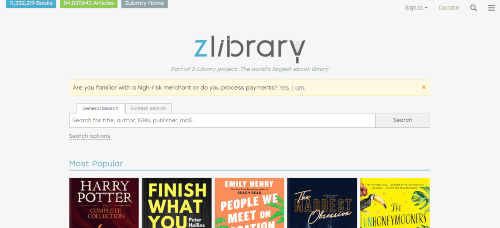
Z-Library is another shadow library website that hosts college textbooks, scholarly journal articles, and general-interest books. It calls itself “the world’s largest e-book library.” It mirrors Library Genesis.
The front page also features some of the most popular books at the time. When we viewed it, these included “Thinking Fast and Slow” by Daniel Kahneman, The Book Thief by Markus Zusak, and Harry Potter the Complete Collection by J. K. Rowling.
You can also use the right-hand navigation menu to see the books that have been added most recently, as well as sort through books based on category.
Use the Book Request option if you can’t find a book you’re looking for. There’s no guarantee your book will be added, but community members look at requests to see what books to upload (you can also upload books).
PDF Drive

PDF Drive is an online library with a ton of free ebooks and PDF textbooks in various categories, including academic & education (but also lifestyle, personal growth, art, linguistics, etc.)
ForCoder.su

Forcoder.su has lots of online textbooks on programming. It also provides free access to online courses, like Apache Kafka for beginners and object-oriented programming with Python. Currently, there are hundreds of free courses available.
Online Mathematics Textbooks
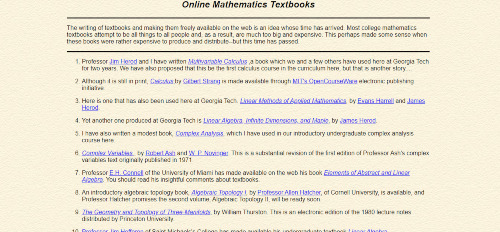
Online Mathematics Textbooks is your source for free digital textbooks on all things math. It’s just one page featuring 77 textbooks.
Tech Books for Free Download

Tech Books for Free Download is where you’ll find free science and engineering books on topics ranging from data mining to general relativity.
There’s no way to search for books easily. However, the site is divided into books on Linux, Java, Microsoft, C and C++, Perl/Python, Science, Networking, Database, Security, and Assembly.
Free Tech Books
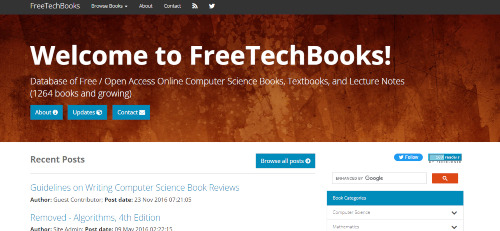
Free Tech Books is an open textbook library. It provides access to free computer science books and textbooks, plus lecture notes. All the books and lecture notes listed on this site are freely available on authors’ and/or publishers’ sites.
You can browse books by category (computer science, mathematics, supporting fields, operating system, programming/scripting, miscellaneous), author, publisher, or license.
Directory of Open Access Books

Directory of Open Access Books (DOAB) is a website that indexes and provides access to academic, peer-reviewed open-access books. All disciplines are covered, but there’s a particular emphasis on humanities, social sciences, and law.
Ubiquity Press

Ubiquity Press has been an open-access publisher of academic, peer-reviewed books and journals since 2012. It was founded by University of College London (UCL) researchers.
Research Papers
Sci-Hub

Sci-hub has the most expansive collection of research papers. Its mission is to “remove all barriers in the way of science.”
Directory of Open Access Journals

Directory of Open Access Journals (DOAJ) is an online directory of open-access, peer-reviewed research journals covering humanities, social sciences, technology, science, medicine, and art.
The directory indexes journals from different countries and languages. DOAJ is supported financially by publishers, libraries, and other organizations.
Wiley Open Access
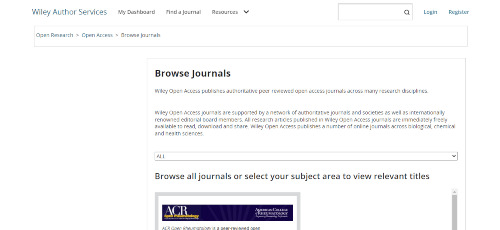
Wiley Open Access provides peer-reviewed open-access journals across topics like biochemistry, economics, sociology, mathematics, and law.
SpringerOpen
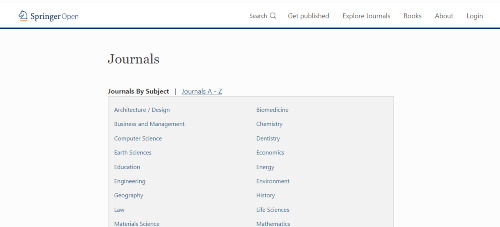
SpringerOpen publishes open-access journals across a wide range of areas, mainly STEM.
Elsevier
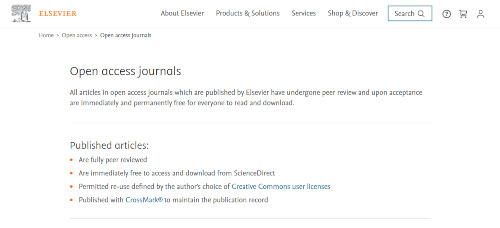
Elsevier publishes open-access, peer-reviewed journals. You can search for journals by title, keyword, or subject (dentistry, nursing, decision sciences, etc.)
Springer Link
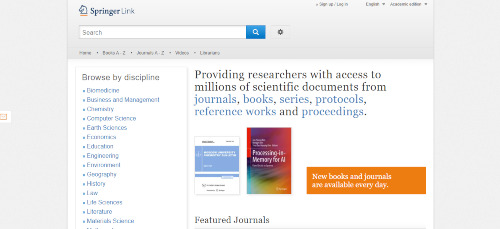
Springer Link provides access to ebooks, peer-reviewed journal articles, and other resources (mostly scientific).
BASE

BASE is a search engine for academic texts, including journals, digital collections, institutional repositories, etc. You can access about 60% of the indexed texts for free.
Study Guides
Bibliomania

Bibliomania has study guides to the most-read books, like “A Hero of Our Time,” “Animal Farm,” and even Irish politics. It also has over 2,000 classic texts, book summaries, author biographies, and more.
Books
Open Library
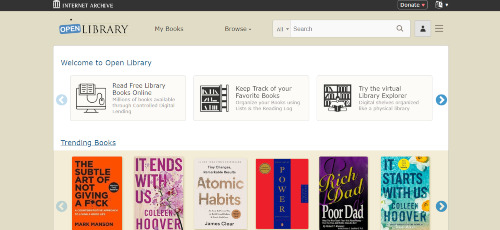
Open Library is an open library catalog of more than 3 million new and old books. The project was created by the nonprofit organization Internet Archive. It has also received partial funding from Kahle/Austin Foundation and the California State Library.
You can read old books without an account. However, for new books, you’ll need to set one up (it takes just a few minutes).
Internet Archive

Internet Archive is a digital library of ebooks. It also has free movies, music, and software.
Project Gutenberg

Project Gutenberg is a famous site where you can find lots of free books. There are more than 60,000 books in its collection.
Standard Ebooks

Standard Ebooks take public domain texts and make them as nice as new books. They fix typographical errors and typos, create cool cover art, and format the text for e-readers like Kindle and iPad.
Planet eBook

Planet eBook is where you can download free PDF copies of classics like Franz Kafka’s The Metamorphosis, Fyodor Dostoyevsky’s Crime and Punishment, and Joseph Conrad’s Heart of Darkness.
What really makes Planet eBook stand out is its UX. It’s one of those rare sites that are super easy to navigate and actually look good (aesthetically speaking).
The Ultimate Book Search Engine

The Ultimate Book Search Engine is an ebook search engine that includes 350 open directory sites that relate to ebooks. It was created by the Reddit user u/NotoriousYEG.
Classic Bookshelf
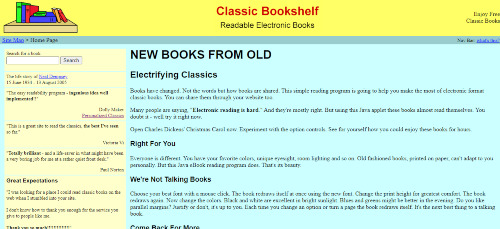
The Classic Bookshelf is a site where you’ll find lots of classic novels, everything from Charles Dickens and Leo Tolstoy.
Literature.org
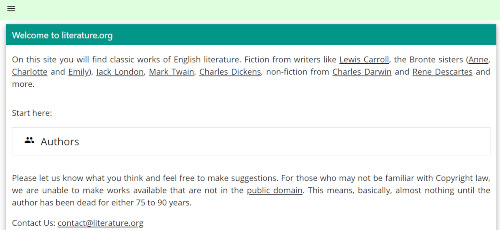
Literature.org features classic works of English literature, both fiction and non-fiction.
Bartleby

Bartleby is a site that features both fiction and nonfiction books.
Fiction.us

Fiction.us has a ton of books, including fiction, short stories, children's picture books, poetry, books on writing, and plays.
Classic Literature Library
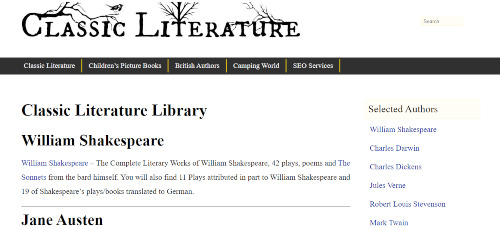
As the name suggests, Classic Literature Library is where you’ll find classic literature works.
Ideology.us

Ideology.us is a site that has ebooks on philosophy, psychology, sociology, politics, and education.
The Complete Works of William Shakespeare

The Complete Works of William Shakespeare is where you’ll find all of Shakespeare’s work. The site is run by The Tech, the largest and oldest newspaper by the Massachusetts Institute of Technology in Cambridge.
Read Books Online

Read Books Online has around 6,000 ebooks, including novels, short stories, poems, essays, plays, and non-fiction.
Public Bookshelf
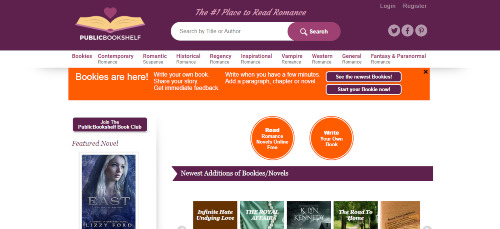
Public Bookshelf is a site dedicated to romance novels.
Categories of ebooks here include contemporary romance, romantic suspense, historical romance, regency romance, inspirational romance, vampire romance, western romance, general romance, and fantasy and paranormal romance.
The Perseus Project

The Perseus Project is a digital library created by Tufts University with books from Ancient Rome and Greece, published in original languages and English.
Chest of Books

Chest of Books has books on a ton of different subjects, including animals, finance, real estate, science, and travel.
The Literature Network
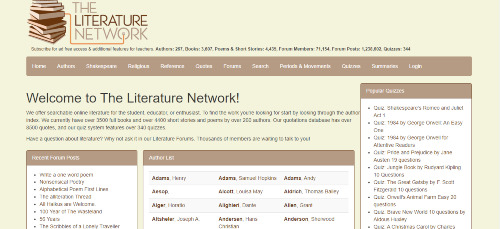
The Literature Network has books by authors like Anne Bronte, Lewis Carroll, and Lord George Gordon Byron. It also features forums, literature summaries, and quizzes.
The Online Books Page
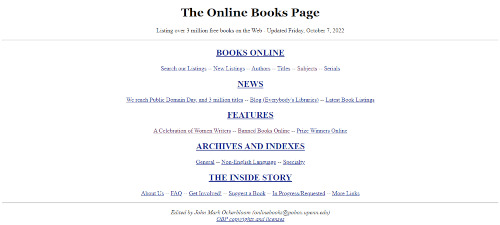
The Online Books Page is a site by the University of Pennsylvania that houses books in categories like philosophy, history, medicine, science, agriculture, music, anthropology, and more. The site also links to the following:
Banned Books Online: A directory of books that were once banned and links to places where you can read them in full.
A Celebration of Women Writers: A directory that lists online editions of literary works by women as well as resources about women writers.
Prize Winners Online: A directory of prize-winning books.
Many Books

Many Books is “your friendly neighborhood library.” It houses over 50,000 books in genres like romance, mystery, young adult, horror, and non-fiction. You can read books online or download them to your device.
Authorama

Authorama turns public domain books on sites like Google Books and Project Gutenberg into HTML format, making it easier to read them.
Audiobooks
Librivox

Librivox has free audiobooks that you can listen to from any device.
#adulthood#young adult#new adult#adulting#how to be an adult#adulting is hard#adulting 101#growing up#grown up#all grown up#responsible#the responsible one#self improvement#self#self sufficiency#self sufficient living#daily life#lifehacks#life improvement#life tips#life hacks#life#tips and tricks#tips#hacks#hack#reference#ref#free shit#college
497 notes
·
View notes
Text
At the time, [Ian] Stevenson was Chair of the Department of Psychiatry at the University of Virginia Medical School. During his more than half-century at the University of Virginia, Stevenson carried out pioneering work in the empirical investigation of the mind-body connection, focusing on phenomena suggesting that contemporary scientific hypotheses concerning the nature of mind, and the mind’s relation to matter, may be seriously incomplete.
Stevenson authored a dozen books and more than two hundred scientific publications related to this work. Stevenson was a meticulous scientist and conservative in his interpretation of data. At the same time, he was a true visionary, and courageous in his study of phenomena that lie outside the current scientific mainstream. Under Stevenson’s leadership, DOPS became the largest and longest-running university-based group in the United States devoted exclusively to empirical investigation of phenomena that are not easily encompassed by the current paradigm in the biophysical sciences for understanding the mind. This paradigm maintains that consciousness is entirely generated by, or emerges from, the physical processes of the brain and body, and can in no way be more than that.
[...]
In 1975, Stevenson began a four-volume series of books called Cases of the Reincarnation Type. The different volumes included carefully documented cases from India, Sri Lanka, Lebanon and Turkey, and Thailand and Burma. When the first volume was published, the book review editor of JAMA: The Journal of the American Medical Association, wrote: “In regard to reincarnation he has painstakingly and unemotionally collected a detailed series of cases from India, cases in which the evidence is difficult to explain on any other grounds.”
[...]
Over the years, Stevenson studied cases of children born with birthmarks or defects that corresponded to wounds (usually the fatal wounds) suffered by the deceased individuals whose lives the children appeared to remember. He went to great lengths to verify that the birthmarks or birth defects did in fact match the previous wounds. He always tried to obtain autopsy reports if they were available, along with medical records or police reports. If no written records were available, he would elicit eyewitness testimony about the wounds.
For many years, he put off publishing reports as his collection continued to grow. Finally, in 1997, Stevenson produced Reincarnation and Biology: A Contribution to the Etiology of Birthmarks and Birth Defects, a 2,200-page, two-volume collection of over two hundred such cases.
He also wrote a shorter synopsis of that work, entitled Where Reincarnation and Biology Intersect. In these books, he included numerous pictures of birthmarks and defects that were often highly unusual. The cases included a girl born with markedly malformed fingers who remembered the life of a man whose fingers were chopped off; a boy with only stubs for fingers on his right hand who remembered the life of a boy in another village who lost the fingers of his right hand in a fodder-chopping machine; and a girl who remembered the life of a man who underwent skull surgery. She had what Stevenson called the most extraordinary birthmark he had ever seen: a three-centimeter wide area of pale, scar-like tissue that extended around her entire head.
He reported that in eighteen cases in which the previous person was shot, the child was born with double birthmarks, ones corresponding to both the entrance and the exit wound on the previous person’s body.
-- David E. Presti (ed.), Mind Beyond Brain: Buddhism, Science, and the Paranormal
9 notes
·
View notes
Text
Himalayan Linguistics, Linguistics Vanguard and the Australian Journal of Linguistics
In 2024 I have returned to my role as an editor of Himalayan Linguistics, and have joined the editorial boards of two other journals; Linguistics Vanguard and the Australian Journal of Linguistics. I've published in each of these journals before joining the editorial boards, and it's lovely to be involved in three journals across three different areas of interest.
Himalayan Linguistics is a fully Open Access journal, while Linguistics Vanguard and the Australian Journal of Linguistics have a mix of open access and licensed content. If you are an academic and your work is relevant to any of these three journals, please consider them for your next research paper!
Himalayan Linguistics
One of my first academic publications was with Himalayan Linguistics in 2013. I've been so grateful for all the work of the editorial team over the years that I joined the board, and then stepped up as editor in 2022. My co-editors are Gregory Anderson and You-Jing Lin.
Himalayan Linguistics costs nothing to read, and charges no fees for publishing. We're lucky to have the University of California eScholarship infrastructure for publishing. It's my favourite model for academic research.
From the website:
Himalayan Linguistics is an online peer-reviewed journal specializing in languages of the Himalayan region. We publish articles, book reviews, book notices and field reports in the semi-annual issues of the journals. We also publish grammars, dictionaries, and text collections as free-standing publications in our “Archive” series. Himalayan Linguistics is free; that is, there is no subscription fee, and there is no fee charged to authors who publish their papers in HL.
My publications in HL, Superlinguo summary posts:
The relationship between Yolmo and Kagate: Article in Himalayan Linguistics
Reported evidentiality in Tibeto-Burman languages
Linguistics Vanguard
Linguistics Vanguard launched in 2015 and I was eyeing it off for years before being delighted to have a chance to submit a paper for the 2023 Special Issue on scifi corpus methods. Yup, it's the kind of journal that's cool enough to have a whole special issue on using corpora to do linguistics on scifi. I have another paper in the revisions process with LV on lingcomm. I can attest to the speedy process and focus on conciseness. I'm delighted to join as an area manager for gesture and multimodal submissions.
Linguistics Vanguard is a new channel for high quality articles and innovative approaches in all major fields of linguistics. This multimodal journal is published solely online and provides an accessible platform supporting both traditional and new kinds of publications. Linguistics Vanguard seeks to publish concise and up-to-date reports on the state of the art in linguistics as well as cutting-edge research papers. With its topical breadth of coverage and anticipated quick rate of production, it is one of the leading platforms for scientific exchange in linguistics. Its broad theoretical range, international scope, and diversity of article formats engage students and scholars alike.
My publications in LV, Superlinguo summary posts:
From Star Trek to The Hunger Games: Emblem gestures in science fiction and their uptake in popular culture
Australian Journal of Linguistics
The Australian Linguistic Society is my local linguistics org, and I'm delighted to join an editorial board full of people whose work I deeply respect. I'm also happy to report the AJL recently adopted the Tromsø Recommendations for data citation.
The Australian Journal of Linguistics is the official journal of the Australian Linguistic Society and the premier international journal on language in Australia and the region. The focus of the journal is research on Australian Indigenous languages, Australian Englishes, community languages in Australia, language in Australian society, and languages of the Australian-Pacific region. The journal publishes papers that make a significant theoretical, methodological and/or practical contribution to the field and are accessible to a broad audience.
My publications in AJL, Superlinguo summary posts:
Ten years of Linguistics in the Pub (Australian Journal of Linguistics)
Revisiting Significant Action and Gesture Categorization
#language#linguistics#journal#academic#research#linguistics vanguard#australian journal of linguistics#himalayan linguistics#LV#HL#AJL#Tromsø recommendations#TRecs
21 notes
·
View notes
Text
preliminary stats
based on the first 114 polls.
general observations
we’ve had 9 majority-yes results so far (7.9% of the total)
highest result to date is Tamsyn Muir’s Gideon the Ninth at a whopping 69.4% yes, followed closely by Martha Wells’s All Systems Red
there are some interesting similarities and some interesting differences between this and the fantasy blog
the fundamental truth that everyone thinks their taste is universal and everyone is wrong remains.
publisher
as with the fantasy polls, big 5 imprints are significantly more likely to have been read — 20.1% yes, vs. only 8.8% yes for other publishers. this difference is currently slightly less pronounced than for the fantasy polls, but also non-big 5 books are less than a quarter of the polls to date. I anticipate with more data it will probably align with the fantasy polls at around 5% yes.
age demographic
we don’t yet have enough data for a meaningful average for either teen/YA or children’s books. the average yes rate for adult books is 16.9%.
note that of the only 6 children’s book polls so far, 2 (33.3%) have been majority-yes. that said, I think that percentage is very unlikely to hold if/when more children’s book polls finish — there are plenty of children’s sci-fi books (I read many!), but there seem to be few that are widely read/beloved.
publication date
these are allllll over the place. the average publication date for the first ~250 submissions to this blog skews significantly older than the fantasy blog (1990 here vs. 2001 there), which initially, frankly, I kind of thought was people posturing by showing off that they’ve read The Classics. I now think it may reflect, rather, a divide between people who follow this blog (or see its posts reblogged) and people who submit books to this blog. the former are perhaps newer sci-fi, or newer adult sci-fi readers, who mainly read/have read things from the last decade; the latter are long-time sci-fi readers who grew up reading classics.
the result of this is a more scattered chart of decades, only some of which have enough submissions for a meaningful average:
1810s: 1 book
1860s: 2 books
1890s: 1 book
1930s: 3 books
1940s: 1 book
1950s: 3 books
1960s: 8 books
1970s: 11 books (average 9.6% yes)
1980s: 16 books (average 12.9% yes)
1990s: 13 books (average 12.4% yes)
2000s: 3 books (???????)
2010s: 35 books (average 20.1% yes)
2020s: 16 books (average 13.2% yes)
where’d the 2000s go???? funny little not-actually-bimodal distribution. as more polls come out I suspect this will probably settle into something a little more regular (maybe an actual bimodal distribution? lmao), and I expect it will continue to be skewed towards the 2010s.
race
this is a nice difference from the fantasy blog! while the number of submissions to this blog is even more overwhelmingly white than the fantasy blog (almost 86% here vs. about 82% there), the read rates are not actually that different: average 17.7% yes for books by white authors and 15.2% yes for books by authors of color.
gender
the gender demographics are the exact opposite here of the fantasy blog: where the fantasy blog’s submissions are about 60% women and about 35% men, the submissions here are about 35% women and about 60% men. and, for some reason, the averages are also reversed: books by men average 15.5% yes and books by women average 19.6% yes.
geography
North America (mainly the US) is at an average of 18.0% yes, and Europe (mainly the UK) is at an average of 14.9% yes. this is again the opposite of the fantasy polls — something about the relative dominance of American science fiction writers. there’s not yet enough data for meaningful statistics about other continents.
language
finally, as with the fantasy blog, the average for books originally published in English is substantially higher (18.5% yes) than the average for books not originally published in English (8.7% yes; 4.3% yes excluding Le Petit Prince). this is similar to the fantasy blog, and I imagine it will stay that way, although it’s possible Liu Cixin and some others will help keep the number a little higher.
19 notes
·
View notes